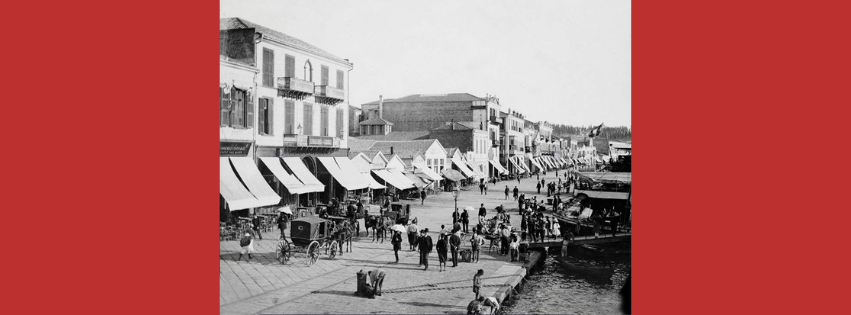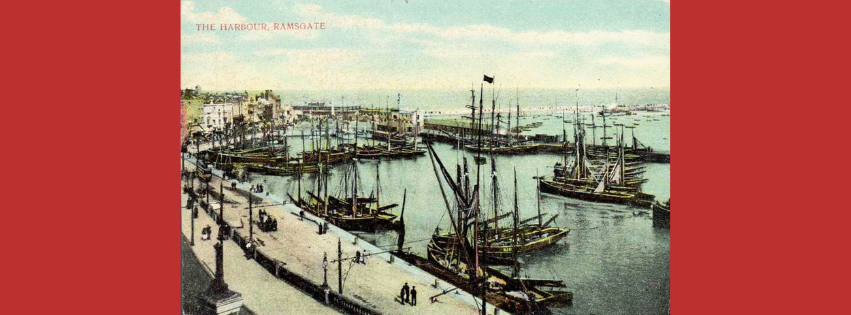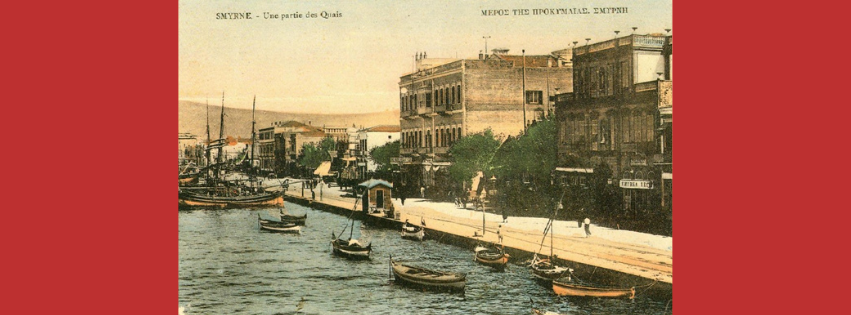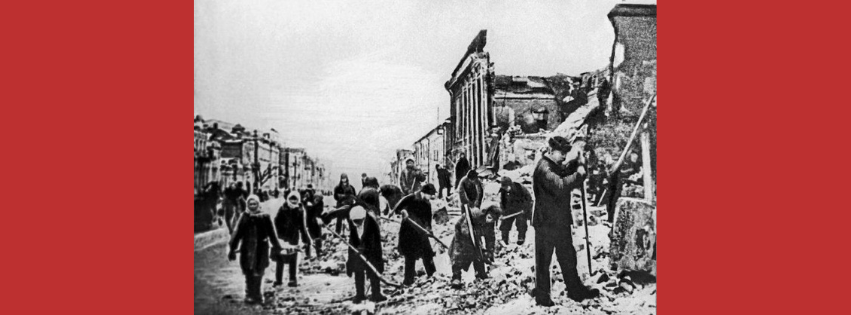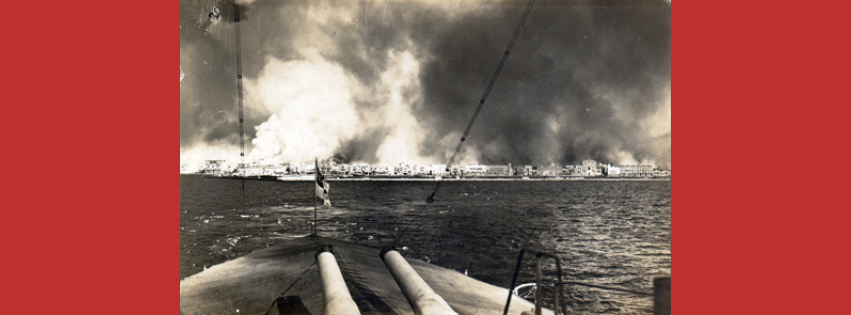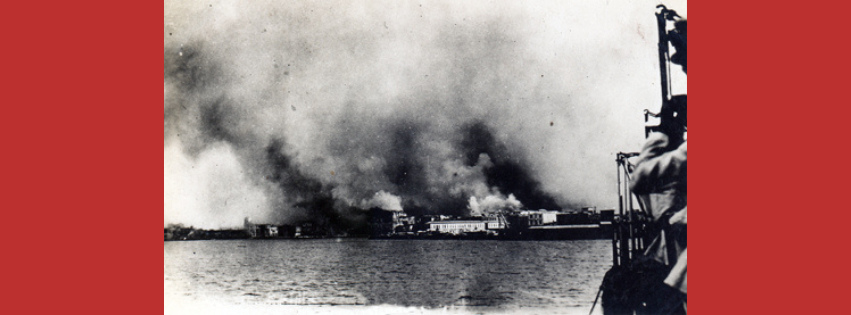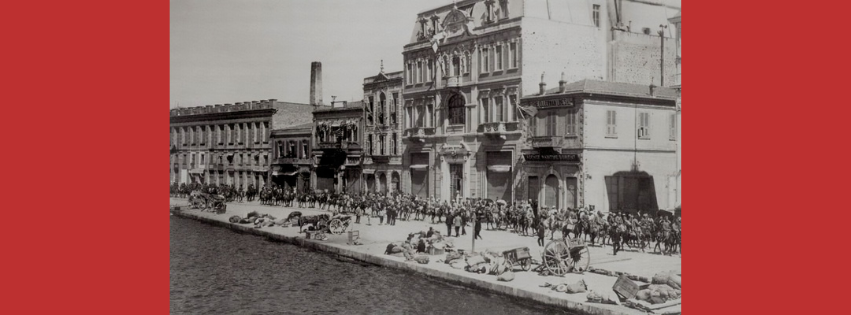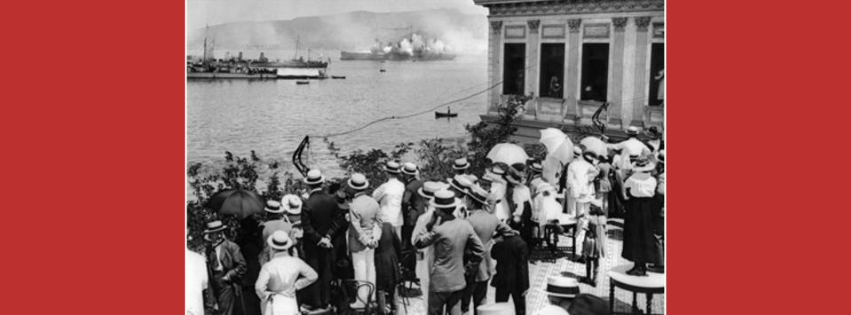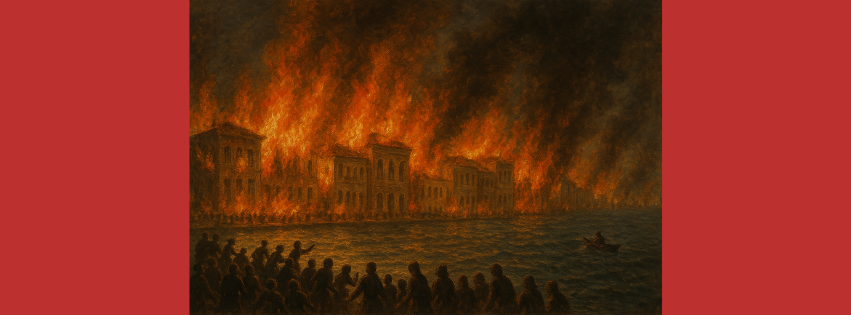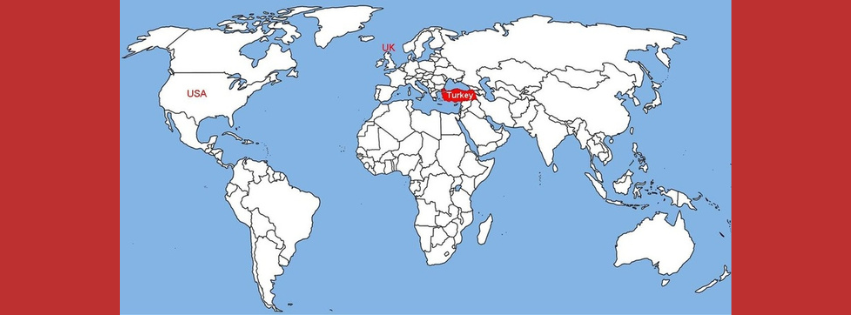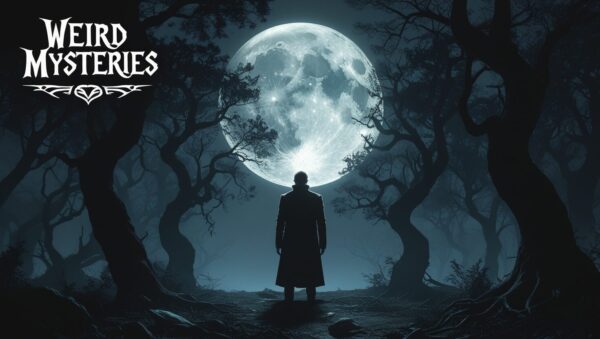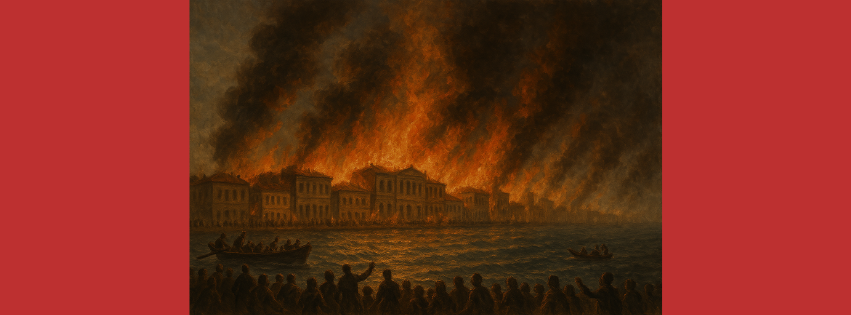
🏛️ Introduction: Smyrna – The City That Had It All
Imagine a city where you could hear Greek bouzoukis playing, smell fresh Turkish spices in the markets, watch Armenian craftsmen carving delicate icons, and walk by Jewish bookshops selling religious scrolls—all in a single afternoon.
That was Smyrna.
At the dawn of the 20th century, Smyrna (modern-day İzmir) was often called the “Paris of the Levant.” It was a glittering cosmopolitan port city on the Aegean coast, known for its diverse population, artistic energy, vibrant economy, and one of the most sophisticated social scenes in the Ottoman Empire.
But in September 1922, all of that was reduced to charred ruins, floating corpses, and desperate screams. The Great Fire of Smyrna wasn’t just a disaster — it was the end of a 3,000-year-old civilization and one of the most haunting crimes of the 20th century.
🧭 Historical Setting: How the Powder Keg Was Lit
🕰️ A City Steeped in Antiquity
Smyrna’s origins go back to at least 1000 BCE. It was once part of the Ionian Greek world, and later absorbed by the Roman Empire, flourishing during the Byzantine era.
By the late 19th century, it had:
- A Greek majority, estimated at over 150,000.
- Large Armenian, Turkish, and Jewish minorities.
- Churches, synagogues, mosques — all operating in harmony (at least on the surface).
- The second-largest Greek city after Athens.
- An elite class that hosted European operas, balls, and international trade fairs.
But Smyrna’s golden days masked rising tensions beneath the surface — worsened by nationalism, imperialism, and the collapse of empires.
⚔️ The Greco-Turkish War: Empire vs. Nationalism
💣 World War I Fallout
After WWI, the Ottoman Empire was defeated and its lands were carved up by Allied powers. The Treaty of Sèvres (1920) awarded Smyrna and parts of Anatolia to Greece — a decision fiercely opposed by emerging Turkish nationalists.
⚔️ Greece’s Military Occupation of Smyrna (1919)
On May 15, 1919, Greek troops landed in Smyrna. The goal? Expand Greek territory under the “Megali Idea” (the dream of a Greater Greece). The city’s Greek residents cheered, but violence erupted almost immediately.
📍 Massacre at the Quay: On the first day, Greek troops and civilians attacked Turkish soldiers and bystanders, sparking a cycle of vengeance that would last for years.
🇹🇷 The Rise of Mustafa Kemal and the Turkish National Movement
Led by Mustafa Kemal (later Atatürk), Turkish nationalists launched a war of independence. By 1922, they had reversed many Greek advances and launched a final assault on Smyrna, the symbolic heart of Greek Anatolia.
On September 9, 1922, Turkish troops entered Smyrna, victorious and vengeful.
🔥 The Fire Begins: September 13, 1922
Just four days after the Turkish victory parade, fire broke out in the Armenian quarter.
🧨 Chain Reaction
- The flames quickly spread to the Greek quarter, accelerated by strong winds and flammable wooden homes.
- Gasoline was reportedly poured on homes to ensure they burned.
- Firebreaks were deliberately not created.
- The fire burned uninterrupted for 4 days, turning night into hellish red skies.
📉 The Toll: A Humanitarian Catastrophe
🧑🤝🧑 Human Impact:
- Death Toll: Conservative estimates say 10,000+, but some place it as high as 100,000, including people who burned alive or drowned trying to flee.
- Displacement: Over 400,000 Greeks and Armenians became instant refugees.
- Refugee Crisis: Quays and streets became open-air refugee camps, filled with wounded civilians, crying children, and corpses.
- Missing Persons: Entire families vanished in the flames.
🧵“I saw women throw their children into the sea to save them from burning.” – Eyewitness, Greek survivor
🚢 The Silent Fleet: 21 Ships, No Help
The harbor was filled with foreign naval ships — from Britain, France, Italy, and the U.S.
And yet… they stood still.
- International policy of neutrality meant the ships could not “interfere” in Turkish internal affairs.
- Refugees swam to the ships — many shot at or turned away.
- Some U.S. sailors were punished for saving drowning women and children without orders.
The American YMCA worker Asa Jennings, though, defied the bureaucracy — working with Greek naval officers to organize a mass evacuation, rescuing over 300,000 people.
🧨 Who Lit the Match? Theories and Accusations
The origins of the fire remain deeply controversial.
🔍 Main Theories:
- Turkish Troops Set the Fire:
- Eyewitness accounts describe Turkish soldiers using kerosene, forcing civilians into burning homes.
- Foreign journalists, including George Horton and Marjorie Housepian, supported this.
- Retreating Armenians or Greeks:
- Some Turkish officials claim Armenians started the fire in revenge.
- This is widely disputed and lacks physical evidence.
- Spontaneous Combustion from Urban Chaos:
- Another theory is that the fire was accidental — fueled by panic, looting, and overcrowding.
📌 Historical Consensus: Most modern historians agree that Turkish nationalist forces were primarily responsible, and that the fire aligned with a broader ethnic cleansing strategy.
🧿 Cultural and Religious Erasure
The fire consumed more than buildings:
- Over 30 churches, some over 1,000 years old, were destroyed.
- Ancient Greek schools, libraries, and Armenian monasteries were lost.
- Priceless icons, relics, and manuscripts turned to ash.
- Cemeteries were desecrated, often bulldozed in the years afterward.
❗ Only the Muslim and Jewish quarters were left largely untouched — leading to more suspicion of deliberate targeting.
🧬 The Forgotten Genocide?
Some scholars place the fire within the continuum of Armenian, Assyrian, and Greek genocides carried out by Ottoman and later Turkish forces between 1914–1923.
- The Greek Genocide (1913–1922): Over 350,000 Greeks were killed or deported.
- The Armenian Genocide (1915–1917): Over 1.5 million Armenians perished.
- The Smyrna fire marked the final blow to Greek and Armenian presence in Asia Minor.
🕊️ The Aftermath: Refugees, Trauma, and Silence
✈️ The Exodus:
- By 1923, under the Treaty of Lausanne, Greece and Turkey exchanged populations.
- Over 1.5 million Greeks were forcibly removed from Anatolia.
- Turkey received around 500,000 Muslims from Greece in return.
😷 The Refugee Experience:
- Refugees arrived in Athens, Thessaloniki, and Piraeus, often barefoot and traumatized.
- Many lived in tents or slums for years.
- Despite the hardship, they contributed to Greek culture in music, food, and politics.
🎖️ Stories of Heroism and Humanity
- Asa Jennings was later honored by both Greece and the U.S., despite operating independently.
- The Greek ship “Kilkis” violated orders to evacuate thousands.
- Turkish Muslims and Jews in Smyrna also hid Christians, risking their lives.
🧠 Memory, Silence, and Denial
- In Turkey, the fire is barely mentioned in school textbooks.
- The story is still taboo in public discourse — with efforts to reframe it as Greek provocation.
- In Greece and the diaspora, it is mourned every year on September 13.
📚 Further Reading and Resources
- Books:
- “Smyrna 1922: The Destruction of a City” – Marjorie Housepian Dobkin
- “Paradise Lost” – Giles Milton
- “The Blight of Asia” – George Horton
- Documentaries:
- “Smyrna: The Destruction of a Cosmopolitan City, 1900–1922” (2012)
- “Asia Minor Catastrophe” by ERT
- Museums:
- Asia Minor Refugee Museum in Nea Filadelfeia, Greece
- Virtual exhibits via Greek and Armenian diaspora archives
🔚 Final Thoughts: A Phoenix That Never Rose
The Great Fire of Smyrna wasn’t just a tragedy — it was the execution of a culture, a people, a way of life.
In those four hellish days, Smyrna lost:
- Its diversity
- Its history
- Its soul
We must remember this fire not just as a past catastrophe, but as a cautionary tale for the future. When nationalism goes unchecked and the world turns away, even the most radiant cities can burn.
50 FAQs on The Great Fire of Smyrna (1922) — With SEO-Rich Answers
1. What was the Great Fire of Smyrna?
The Great Fire of Smyrna was a devastating blaze that erupted in the city of Smyrna (modern-day İzmir, Turkey) in September 1922, destroying most of the Armenian and Greek quarters and resulting in tens of thousands of deaths and mass displacement.
2. When did the Great Fire of Smyrna take place?
The fire started on September 13, 1922, and burned for four days, finally extinguished on September 17, 1922.
3. Where is Smyrna located today?
Smyrna is now known as İzmir, a major port city on the Aegean coast of Turkey.
4. Who was responsible for the Great Fire of Smyrna?
Most historians believe the fire was intentionally set by Turkish nationalist forces, although the Turkish government at the time blamed Armenians and retreating Greeks. Eyewitnesses and foreign consuls mostly supported the former view.
5. How many people died in the Great Fire of Smyrna?
Estimates range from 10,000 to 100,000 deaths, though the exact number remains disputed due to the chaos and destruction of records.
6. How many people were displaced by the fire?
Over 400,000 Greek and Armenian civilians were displaced, creating one of the largest refugee crises in the early 20th century.
7. Why is the Great Fire of Smyrna historically important?
It marked the violent end of Greek and Armenian communities in Asia Minor, contributing to the ethnic cleansing and genocide narrative in the Ottoman Empire’s collapse.
8. Was the fire part of the Armenian or Greek Genocide?
Many scholars consider it the final stage of the Greek Genocide and part of the broader Christian genocides (Greek, Armenian, Assyrian) that occurred from 1914 to 1923.
9. What caused the fire to spread so quickly?
The city’s architecture — densely packed wooden houses, strong Aegean winds, and a lack of firebreaks — allowed the flames to spread uncontrollably.
10. Were any parts of the city spared by the fire?
Yes, the Turkish and Jewish quarters of the city remained mostly untouched, which led many to suspect targeted arson.
11. How did foreign powers respond to the fire?
Although 21 Allied ships were anchored nearby, they largely chose non-intervention, only helping with evacuations after public pressure. Some sailors disobeyed orders to rescue civilians.
12. Did anyone try to stop the fire?
Local firefighting efforts were overwhelmed. The Turkish army and occupying authorities reportedly did little to stop the flames, and in some cases even hindered firefighting.
13. What role did Asa Kent Jennings play in the aftermath?
Asa Jennings, a disabled American YMCA worker, coordinated the rescue of over 300,000 refugees by organizing Greek ships and negotiating with Turkish officials. He is celebrated as a hero of humanity.
14. What happened to the survivors of the fire?
Survivors fled to Greece and other countries, where they lived as refugees, often in poverty. Many became influential in Greek culture and politics.
15. What happened to the Greek and Armenian heritage in Smyrna?
Most of it was completely destroyed — churches, schools, libraries, monuments, and graveyards were either burned or later erased.
16. Are there any memorials for the fire today?
There are memorials in Greece, Armenia, and among diaspora communities, but none in modern-day İzmir, where the fire is rarely discussed publicly.
17. Is the Great Fire of Smyrna taught in Turkish schools?
It is minimally or not taught at all in Turkish education systems, and often blamed on Armenians or Greeks in official narratives.
18. Is the Great Fire of Smyrna considered a genocide?
While not legally recognized as a genocide, many scholars classify it as part of the broader genocidal events against Christians in the Ottoman Empire.
19. How did the Treaty of Lausanne affect the region after the fire?
It legalized a forced population exchange between Greece and Turkey, uprooting millions from their ancestral homes permanently.
20. What was the Megali Idea, and how did it relate to Smyrna?
The Megali Idea was Greece’s vision of reviving the Byzantine Empire by reclaiming historically Greek territories — including Smyrna — which led to the Greco-Turkish War.
21. Which journalist documented the fire in detail?
George Horton, the American Consul in Smyrna, and Marjorie Housepian Dobkin, author of “Smyrna 1922,” are among the most cited witnesses and researchers.
22. What are the best books on the Great Fire of Smyrna?
- “Smyrna 1922” by Marjorie Housepian Dobkin
- “Paradise Lost” by Giles Milton
- “The Blight of Asia” by George Horton
23. Was the fire an accident or deliberate?
Most evidence supports the theory that it was deliberately set, with coordinated efforts to target non-Muslim communities.
24. What was Smyrna like before the fire?
It was a thriving multicultural city with Greeks, Armenians, Jews, and Turks living side-by-side. It had churches, synagogues, schools, and European-style cafes.
25. What was destroyed in the fire?
Over 70% of the city, including nearly all Greek and Armenian quarters, 30+ churches, hundreds of homes, and businesses, were destroyed.
26. What happened to the Greek army in Smyrna?
The Greek army retreated in disarray after Turkish forces advanced, leaving many civilians behind without protection.
27. Did the Ottoman Empire still exist at the time of the fire?
Technically, yes — but the empire had effectively collapsed. Mustafa Kemal’s nationalist government was the real power on the ground.
28. Who was Mustafa Kemal Atatürk and what was his role?
He led the Turkish National Movement to victory in the War of Independence and was the de facto leader during the fall of Smyrna. He later became Turkey’s first president.
29. Why is the Great Fire of Smyrna often forgotten?
Because of political sensitivities, denial, and shifting narratives — especially in Turkey, where acknowledging it challenges national identity myths.
30. What religions were practiced in Smyrna before 1922?
Greek Orthodoxy, Armenian Christianity, Islam, Judaism, and smaller Protestant and Catholic communities all coexisted.
31. Were women and children especially targeted?
Yes, many women were raped, trafficked, or killed, and children were orphaned or sold into slavery.
32. What did foreign witnesses say about the fire?
They described unspeakable horrors, forced evictions, systematic burning, and intentional terrorization of Christians.
33. Is there video footage or photos of the Great Fire?
Yes, some rare archival photos and newsreel footage exist, showing the burning city and desperate refugees.
34. Did any international court address the tragedy?
No — there was no international legal tribunal or accountability for the crimes committed during the fire.
35. How did the fire affect modern İzmir?
İzmir was rebuilt as a Turkish national city, largely erasing its multicultural past. Today, it is a major urban center but with little visible trace of its Greek and Armenian history.
36. Is Smyrna mentioned in the Bible?
Yes. Smyrna is one of the Seven Churches of Revelation mentioned in the New Testament Book of Revelation.
37. Was there any Armenian resistance during the fire?
A few reports suggest armed Armenian civilians tried to defend their homes but were vastly outnumbered and outgunned.
38. What were the long-term consequences for Greece?
The sudden influx of refugees caused a social and economic crisis in Greece but eventually contributed to the modernization of Greek society.
39. How do Armenians remember the fire today?
As part of the final chapter of the Armenian Genocide, with commemorations held in Armenian diaspora communities.
40. What happened to Smyrna’s libraries and archives?
They were burned or looted, resulting in an irreparable cultural loss of manuscripts, rare books, and church records.
41. How did the U.S. government respond?
The U.S. government maintained official neutrality, although individual citizens and charities played major roles in rescue efforts.
42. Was Smyrna ethnically cleansed?
Yes — the fire was followed by mass expulsions, killings, and forced removals, effectively cleansing the city of its Greek and Armenian populations.
43. What happened to Smyrna’s Christian churches?
Most were burned, desecrated, or later converted. Only a few foundations or ruins remain today.
44. Did any artists or poets write about the fire?
Yes, many Greek, Armenian, and Western writers composed poetry, memoirs, and novels inspired by the tragedy.
45. Was Smyrna the last major event in the Greek genocide?
Yes, it was the climactic and final blow to the Greek communities of Asia Minor.
46. How do modern Turks view the event?
Reactions vary — some view it as justified retaliation, while a growing number of Turkish historians and citizens are beginning to acknowledge the tragedy.
47. Are there any survivor testimonies?
Yes, many have been recorded in books, documentaries, and university archives in Greece, the U.S., and Armenia.
48. Was the Jewish community affected?
Surprisingly, Smyrna’s Jewish quarter was spared. Some Jews even hid Christian neighbors, showing acts of bravery.
49. What happened to the Armenian Patriarchate in Smyrna?
It was destroyed in the fire, and Armenian religious leadership fled the city permanently.
50. How is the Great Fire of Smyrna remembered today?
In Greece and among global diasporas, it is remembered as a cultural genocide, a day of mourning, and a symbol of lost heritage.




